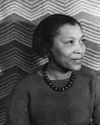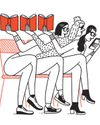
Boston presented an ideal of basketball in action—hoops as jazz, or as democracy.
The N.B.A. makes for good television because basketball’s a sport that bends around stars. The players wear no face-obstructing gear—no helmets, no long-brimmed hats casting shadows—and the presence of a single great performer can guarantee a degree of success for his team. Satisfaction after a made shot, befuddlement after a miss, irritation at a teammate who keeps rushing to the wrong spot: it’s all clear as day, written on the body as much as on the face. Few things are more thrilling than the sudden onrush of protagonism that clings to a player who’s hit a few shots in a row and is about to make the story of the game about himself. The Finals, especially, are a factory for new stars.
Television cameras—in the most immediate case, the ABC cameras that captured the recently concluded Finals confrontation, between the Boston Celtics and the Dallas Mavericks—participate in this effect. They find the right figures and follow them around the court, tracking their moods. Back in the nineties, NBC helped to usher in the era of Michael Jordan; when he wasn’t on camera, making magic, broadcasters such as Bob Costas were busy eloquently showering him with stardust. Jordan became not just a player in a game but a character in a story.
Esta historia es de la edición July 01, 2024 de The New Yorker.
Comience su prueba gratuita de Magzter GOLD de 7 días para acceder a miles de historias premium seleccionadas y a más de 9,000 revistas y periódicos.
Ya eres suscriptor ? Conectar
Esta historia es de la edición July 01, 2024 de The New Yorker.
Comience su prueba gratuita de Magzter GOLD de 7 días para acceder a miles de historias premium seleccionadas y a más de 9,000 revistas y periódicos.
Ya eres suscriptor? Conectar

MING HAN ONG
Thadeus had never offered to take Johnny Mac out for a meal before. This is new, Johnny Mac says, grinning. For twenty-five years, Johnny Mac worked as a tenant-rights lawyer. He is a fount of varied and surprising knowledge.

ZORA NEALE HURSTON'S CHOSEN PEOPLE
What a long-unpublished novel reveals about her magnificent obsession.

FEAR AND LOATHING
Are all our arguments really over who's harmed?

ODD JOBS
\"Severance,\" on Apple TV+.

ON A MISSION FROM GOD
Inside the movement to redirect billions of taxpayer dollars to private religious schools.

MAKE HIM LAUGH
How Lorne Michaels's sensibility governs \"Saturday Night Live.\"

TABULA RASA
“Bleb” is worth eight points in Scrabble. Thought you might like to know. I have known the word since Wednesday, June 11, 1958, when I learned it from a company physician at Time Incorporated, in Rockefeller Center. He said I should have been hospitalized four days ago, but there was nothing much to do about it now, go back to work.

WELCOME TO OUR FIRST/FINAL BOOK CLUB!
Thank you, everyone, for coming to our first/final book-club meeting. Apologies for how long it's taken us to settle on a date, but in between work, kids, and the pretense of joining adult recreational sports leagues, it seems that we all have incredibly busy schedules.

THE POISON MACHINE
The talk-show host Yinon Magal's hard-line tactics.

MEAN TIME
“Hard Truths.”